Honolulu, Hawaii 作者: 来源: 发布时间:2021-07-20
I.Population and Area
₋Area
Land: 60.5 sq mi (156.7 km2)
₋Population
Total: 337, 256
Density: 5,791/sq mi (2,236.1/km2)
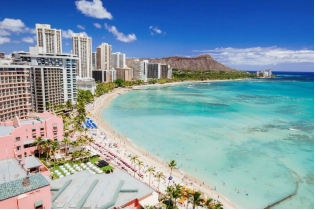
II.Natural Geography
₋Honolulu is the capital and largest city of the U.S. state of Hawaii. It is an unincorporated part of and the county seat of the City and County of Honolulu along the southeast coast of the island of Oʻahu.[a] The city is the main gateway to Hawaiʻi and a major portal into the United States. The city is also a major hub for international business and military defense, as well as being host to a diverse variety of east–west and Pacific cultures, cuisine, and traditions.
₋Honolulu is the westernmost and southernmost major U.S. city. For statistical purposes, the United States Census Bureau recognizes the approximate area commonly referred to as "City of Honolulu" (not to be confused with the "City and County") as a census county division (CCD). Honolulu is a major financial center of the islands and of the Pacific Ocean. The population of the Honolulu census designated place (CDP) was 345,064 as of the 2019 population estimate, while the Honolulu CCD was 390,738.
₋Honolulu means "sheltered harbor"or "calm port" in Hawaiian. The old name is Kou, a district roughly encompassing the area from Nuʻuanu Avenue to Alakea Street and from Hotel Street to Queen Street which is the heart of the present downtown district The city has been the capital of the Hawaiian Islands since 1845 and gained historical recognition following the attack on Pearl Harbor by Japan near the city on December 7, 1941.
₋As of 2015, Honolulu was ranked high on world livability rankings, and was also ranked as the 2nd safest city in the U.S. It is also the most populated Oceanian city outside Australasia and ranks second to Auckland as the most-populous city in Polynesia.
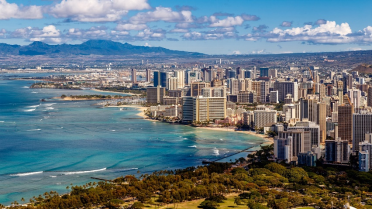
III.GDP
₋The average salary in Honolulu, HI is $65k. Trends in wages increased by 4.3 percent in Q1 2020. The cost of living in Honolulu, HI is 88 percent higher than the national average. The most popular occupations in Honolulu, HI are Operations Manager, Project Manager, (Unspecified Type / General), and Project Engineer which pay between $39k and $119k per year. The most popular employers in Honolulu, HI are Hawaiian Airlines Inc, University of Hawaii, and Hawaii Medical Service Association (HMSA).
₋Website: https://www.payscale.com/research/US/Location=Honolulu-HI/Salary
IV.Industrial Characteristics
₋The largest city and airport in the Hawaiian Islands, Honolulu acts as a natural gateway to the islands' large tourism industry, which brings millions of visitors and contributes $10 billion annually to the local economy. Honolulu's location in the Pacific also makes it a large business and trading hub, particularly between the East and the West. Other important aspects of the city's economy include military defense, research and development, and manufacturing.
V.Attractions
1.Diamond Head
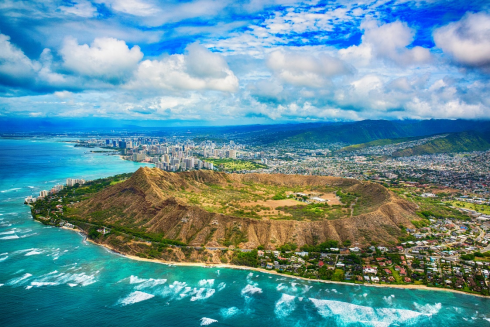
₋Diamond Head is a volcanic tuff cone on the Hawaiian island of Oʻahu and known to Hawaiians as Lēʻahi. The Hawaiian name is most likely derived from lae (browridge, promontory) plus ʻahi (tuna) because the shape of the ridgeline resembles the shape of a tuna's dorsal fin. Its English name was given by British sailors in the 19th century, who mistook calcite crystals on the adjacent beach for diamonds.
₋Diamond Head is part of the system of cones, vents, and their associated eruption flows that are collectively known to geologists as the Honolulu Volcanic Series, eruptions from the Koʻolau Volcano that took place long after the volcano formed and had gone dormant. These eruptive events created many of Oʻahu's well-known landmarks, including Punchbowl Crater, Hanauma Bay, Koko Head, and Mānana Island in addition to Diamond Head.
₋Diamond Head, like the rest of the Honolulu Volcanic Series, is much younger than the main mass of the Koʻolau Mountain Range. While the Koʻolau Range is about 2.6 million years old, Diamond Head is estimated to be about 500,000 to 400,000 years old.
₋Website: https://hawaiistateparks.org/parks/oahu/diamond-head-state-monument/
2. Hanauma Bay
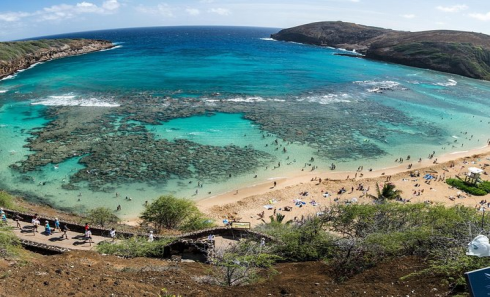
₋Hanauma is a marine embayment formed within a tuff ring and located along the southeast coast of the Island of Oʻahu in the Hawaii Kai neighborhood of East Honolulu, in the Hawaiian Islands.
₋Hanauma is one of the most popular tourist destinations on the Island and has suffered somewhat from overuse. At one time, this popular tourist destination accommodated over three million visitors per year. In 1956, dynamite was used to clear portions of the reef to make room for telephone cables linking Hawaii to the west coast of the US.
₋The prefix hana means bay in the Hawaiian language (the usual addition of bay in its name is thus redundant). There are two etymological interpretations of the second part of its name. One interpretation derives it from the Hawaiian word for curve, referring to either the shape of the feature or to the shape of the indigenous canoes that were launched there. Another stems from the indigenous hand-wrestling game known as "Uma".
₋Website: https://hanaumabaystatepark.com/
3. Bernice Pauahi Bishop Museum
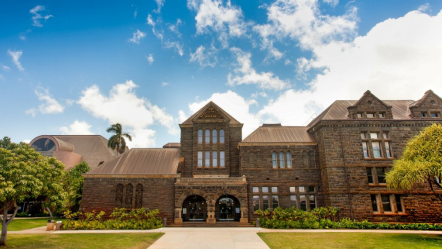
₋The Bernice Pauahi Bishop Museum, designated the Hawaiʻi State Museum of Natural and Cultural History, is a museum of history and science in the historic Kalihi district of Honolulu on the Hawaiian island of O'ahu. Founded in 1889, it is the largest museum in Hawai'i and has the world's largest collection of Polynesian cultural artifacts and natural history specimens. Besides the comprehensive exhibits of Hawaiiana, the museum's total holding of natural history specimens exceeds 24 million, of which the entomological collection alone represents more than 13.5 million specimens (making it the third-largest insect collection in the United States). The museum is accessible on public transit: TheBus Routes A, 1, 2, 7, 10. The museum complex is home to the Richard T. Mamiya Science Adventure Center.
₋Charles Reed Bishop (1822–1915), a businessman and philanthropist, co-founder of the First Hawaiian Bank and Kamehameha Schools, built the museum in memory of his late wife, Princess Bernice Pauahi Bishop (1831–1884). Born into the royal family, she was the last legal heir of the Kamehameha Dynasty, which had ruled the Kingdom of Hawaiʻi between 1810 and 1872. Bishop had originally intended the museum to house family heirlooms passed down to him through the royal lineage of his wife.
₋Bishop hired William Tufts Brigham as the first curator of the museum; Brigham later served as director from 1898 until his retirement in 1918.
₋The museum was built on the original boys' campus of Kamehameha Schools, an institution created at the bequest of the Princess, to benefit native Hawaiian children; she gave details in her last will and testament. In 1898, Bishop had Hawaiian Hall and Polynesian Hall built on the campus, in the popular Richardsonian Romanesque architectural style. The Pacific Commercial Advertiser newspaper dubbed these two structures as "the noblest buildings of Honolulu".
₋Today both halls are listed on the National Register of Historic Places. Hawaiian Hall is home to a complete sperm-whale skeleton, accompanied by a papier-mâché body suspended above the central gallery. Along the walls are prized koa wood display cases; today this wood in total is worth more than the original Bishop Museum buildings.
₋Address: 1525 Bernice St, Honolulu, HI 96817, United States
₋Website: https://www.bishopmuseum.org/
VI.History
₋Evidence of the first settlement of Honolulu by the original Polynesian migrants to the archipelago comes from oral histories and artifacts. These indicate that there was a settlement where Honolulu now stands in the 11th century. After Kamehameha I conquered Oʻahu in the Battle of Nuʻuanu at Nuʻuanu Pali, he moved his royal court from the Island of Hawaiʻi to Waikīkī in 1804. His court relocated in 1809 to what is now downtown Honolulu. The capital was moved back to Kailua-Kona in 1812.
₋In 1794, Captain William Brown of Great Britain was the first foreigner to sail into what is now Honolulu Harbor. More foreign ships followed, making the port of Honolulu a focal point for merchant ships traveling between North America and Asia.
₋In 1845, Kamehameha III moved the permanent capital of the Hawaiian Kingdom from Lahaina on Maui to Honolulu. He and the kings that followed him transformed Honolulu into a modern capital, erecting buildings such as St. Andrew's Cathedral, ʻIolani Palace, and Aliʻiōlani Hale. At the same time, Honolulu became the center of commerce in the islands, with descendants of American missionaries establishing major businesses in downtown Honolulu.
₋Despite the turbulent history of the late 19th century and early 20th century, such as the overthrow of the Hawaiian monarchy in 1893, Hawaiʻi's subsequent annexation by the United States in 1898, followed by a large fire in 1900, and the Japanese attack on Pearl Harbor in 1941, Honolulu remained the capital, largest city, and main airport and seaport of the Hawaiian Islands.
₋An economic and tourism boom following statehood brought rapid economic growth to Honolulu and Hawaiʻi. Modern air travel brings, as of 2007, 7.6 million visitors annually to the islands, with 62.3% entering at Honolulu International Airport. Today, Honolulu is a modern city with numerous high-rise buildings, and Waikīkī is the center of the tourism industry in Hawaiʻi, with thousands of hotel rooms. The UK consulting firm Mercer, in a 2009 assessment "conducted to help governments and major companies place employees on international assignments", ranked Honolulu 29th worldwide in quality of living; the survey factored in political stability, personal freedom, sanitation, crime, housing, the natural environment, recreation, banking facilities, availability of consumer goods, education, and public services including transportation.
VII.Other Information
₋Public transport
₋Honolulu Authority for Rapid Transportation
₋In November 2010, voters approved a charter amendment to create a public transit authority to oversee the planning, construction, operation and future extensions to Honolulu's future rail system. The Honolulu Authority for Rapid Transportation (HART) currently includes a 10-member board of directors; three members appointed by the mayor, three members selected by the Honolulu City Council, and the city and state transportation directors. The opening of the Honolulu Rail Transit is delayed until approximately March 2021, as HART canceled the initial bids for the first nine stations and intends to rebid the work as three packages of three stations each, and allow more time for construction in the hope that increased competition on smaller contracts will drive down costs; initial bids ranged from $294.5 million to $320.8 million, far surpassing HART's budget of $184 million.
₋Bus
₋Established by former Mayor Frank F. Fasi as the replacement for the Honolulu Rapid Transit Company (HRT), Honolulu's TheBus system was honored in 1994–1995 and 2000–2001 by the American Public Transportation Association as "America's Best Transit System". TheBus operates 107 routes serving Honolulu and most major cities and towns on Oʻahu. TheBus comprises a fleet of 531 buses, and is run by the non-profit corporation Oʻahu Transit Services in conjunction with the city Department of Transportation Services. As of 2006, Honolulu was ranked 4th for highest per-capita use of mass transit in the United States.
₋The island also features TheHandi-Van. available for riders who require para transit operations. To be eligible for these parantransit service, individuals must meet the requirements of the Americans with Disabilities Act (ADA). TheHandi-Van has a fare of $2.00, available Mondays - Sundays from 4:00 am – 1:00 am. There is a 24 hours per day service but only within 3/4 of a mile of TheBus route 2 and route 40. TheHandi-Van comprises a fleet of 160 buses. Additionally the parantransit branch also run's Human Services Transportation Coordination (HSTCP), which mainly provides transportation for people with disabilities, older adults, and people with limited incomes, assisted by the Committee for Accessible Transportation (CAT). Both organizations work together to provide transportation for elderly and persons with disabilities.
₋Rail
₋Currently, there is no urban rail transit system in Honolulu, although electric street railways were operated in Honolulu by the now-defunct Honolulu Rapid Transit Company prior to World War II. Predecessors to the Honolulu Rapid Transit Company were the Honolulu Rapid Transit and Land Company (began 1903) and Hawaiian Tramways (began 1888).
₋The City and County of Honolulu is currently constructing the 20-mile (32 km) rail transit line that will connect Honolulu with cities and suburban areas near Pearl Harbor and in the Leeward and West Oahu regions. The Honolulu High-Capacity Transit Corridor Project is aimed at alleviating traffic congestion for West Oʻahu commuters while being integral in the westward expansion of the metropolitan area. The project, however, has been criticized by opponents of rail for its cost, delays, and potential environmental impacts, but the line is expected to have large ridership.
₋Bicycle sharing
₋Since June 28, 2017, Bikeshare Hawaii administers the bicycle sharing program in O'ahu while Secure Bike Share operates the Biki system. Most Biki stations are located between Chinatown/Downtown and Diamond Head, however an expansion in late 2018 added more stations towards the University of Hawai'i Manoa Campus, Kapi'olani Community College, Makiki, and Kalihi area. The GoBiki.org website has a Biki stations map.
₋Modal characteristics
₋According to the 2016 American Community Survey (five-year average), 56 percent of Urban Honolulu residents commuted to work by driving alone, 13.8 percent carpooled, 11.7 used public transportation, and 8.7 percent walked. About 5.7 commuted by bike, taxi, motorcycle or other forms of transportation, while 4.1 percent worked at home.
₋The city of Honolulu has a high percentage of households without a motor vehicle. In 2015, 16.6 percent of Honolulu households lacked a car, which increased slightly to 17.2 percent in 2016 – in comparison, the United States national average was 8.7 percent in 2016. Honolulu averaged 1.4 cars per household in 2016, compared to a national average of 1.8.
VIII.Contact Information
₋Government
Mayor: Kirk Caldwell (D)
₋City Hall
₋Address:
2270 Kalakaua Avenue, Suite 801
Honolulu, HI 96815
₋From the U.S. 1-800-GoHawaii (1-800-464-2924)
₋China: gohawaii.com/cn
₋Website: https://www.gohawaii.com/contact-us
